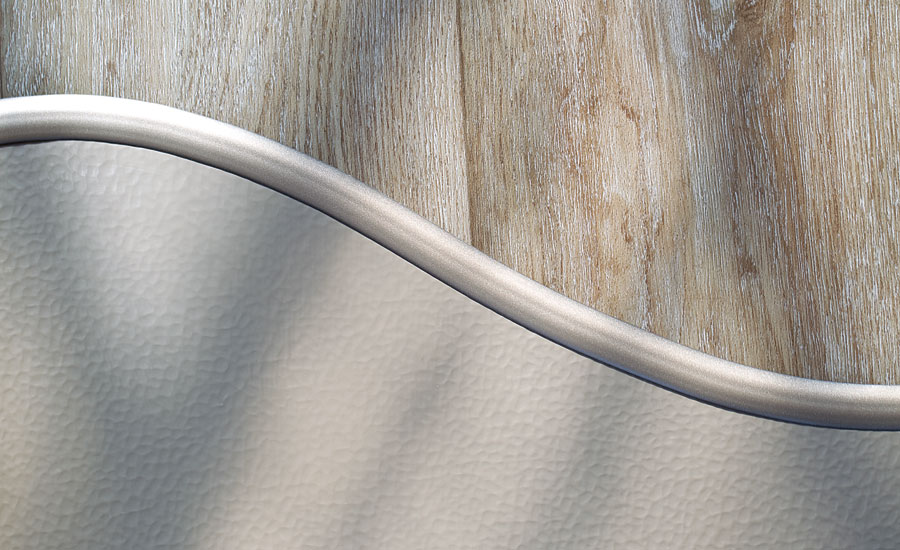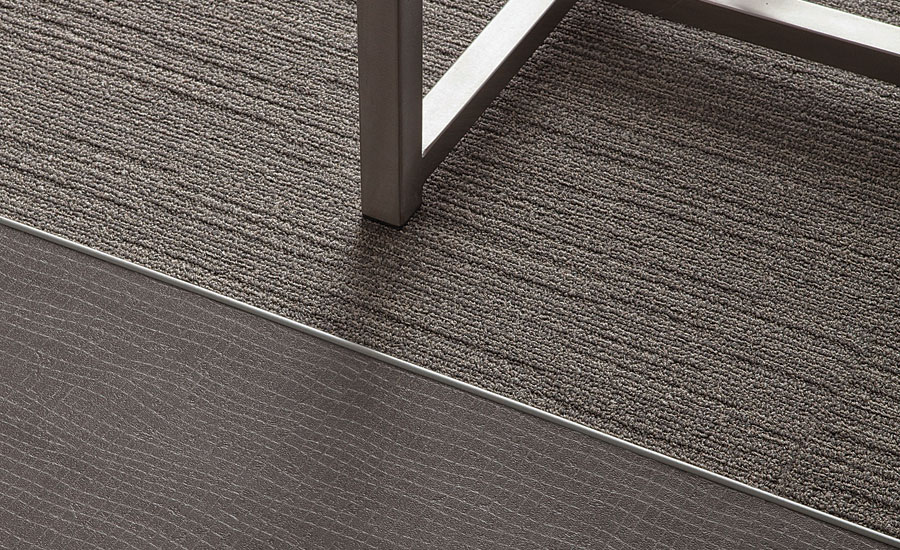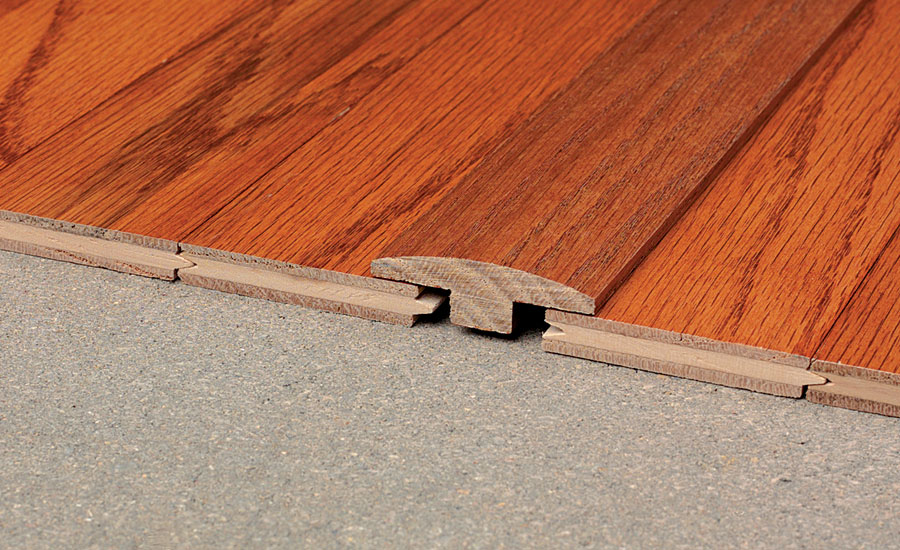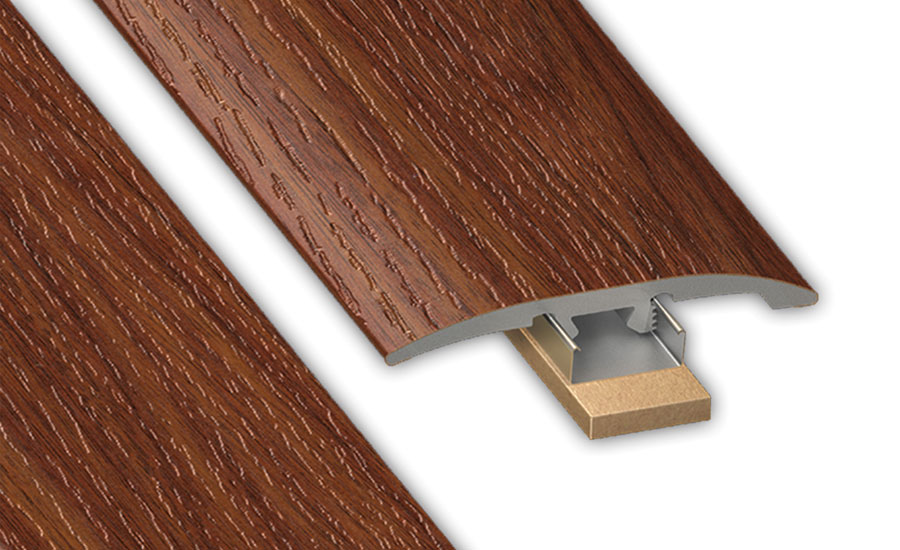Trends in Flooring Transitions

When a transition is necessary, consumer preference is to have the transition blend into the material type and colorations of one of the floorings. This would be satisfied by the matching transitions that Tarkett has introduced across both its LVT and laminate lines.



Versatrim’s Slim Trim Molding (above) functions as a reducer, T-molding, and end cap. The Versa Edge Extra Tall universal molding is used to finish floor on stairs.




In a perfect world, flooring flows seamlessly from room to room. For the instances where it doesn’t, transition moldings help to preserve the structural integrity and beauty of the finished floor. However, understanding which molding or transition pieces are required to complete a flooring project can be confusing.
“Moldings are a tough part of the business because a moldings mill is trying to duplicate a flooring color, texture and sheen of a floor they did not manufacture,” said Mark V. Pacacha, national sales manager for Seneca Millwork. “The flooring mechanic can help immensely if he or she would plan ahead by matching the molding to the closest piece of flooring that will abut next to the molding.”
We asked industry professionals to share their recommendations, as well as discuss the hottest trends right now in transition flooring.
What’s What in Transitions
James Johnson, commercial segment manager for Armstrong Flooring, said the main profiles that are needed for flooring transitions are the T-molding and reducer.
“T-moldings are used to cover the expansion space between two flooring surfaces of approximately the same height,” Johnson said. “If flooring expansion is a factor (i.e. for hardwood) then the T-molding must not be fastened to the flooring. Reducers equalize the level between two flooring surfaces with different heights.”
Tina Keeton Emery, office and sales manager for Versatrim, Inc., recommended the customer purchase the Versatrim 3-in-1 molding SlimTrim, which functions as a T-molding, end cap and reducer.
“It comes standard with a track and shim that will accommodate floor thickness of up to 6 mm or they can request the dowel option that will allow the trim to work with any floor thickness up to 3/4-inch (19mm),” she said.
For prefinished floors, a “fit” is done for each flooring collection that is sent in. “The guesswork is taken out of what the tongue and groove relation is so the installer has no worries here about shimming or cutting the backs of moldings,” Pachaca said.
When it comes to reducers, some floors can be fit to take a traditional reducer and an overlap reducer. “Most prefinished floor options offer only stair nosing,” Pacacha said. “Full stair treads are also available and is something all industry professionals should know.”
Quarter round and shoe molding are universal in size and T-molds and thresholds are virtually universal as well, he added.
Teiya Eubanks, content marketing manager for Tarkett, spoke to both residential and commercial settings. When a transition is necessary for residential work, a consumer preference is to have the transition blend into the material type and colorations of one of the floorings. This would be satisfied by the matching transitions that Tarkett has introduced across both the LVT and laminate lines, she said.
She noted that in a commercial environment it is important to understand that any transitions can create a slip/fall hazard, therefore minimizing transitions on the floor surface would be the first priority (i.e. promoting leveler strips).
“If I need to transition on a surface, ADA compliance and minimizing slip/fall risk become priority, followed by aesthetic—minimizing the overall size of this transition while still maintaining compliance and safety is trend,” Eubanks said.
Eric Flom, founder of Intersource, Inc., kept it simple: “The Johnsonite catalog and website are key resources. We utilize our labor partner and the team on the desk of Hank’s Specialties, our local Tarkett/Johnsonite distributor, for questions about which molding is appropriate.”
He said occasionally a trip to the job site with molding profiles in hand is necessary to ensure proper fit and performance between adjacent floor finishes.
“Save all usable balance pieces,” Flom added. “You will use them on future jobs. More than likely a few headaches will be prevented, too. Saving the pieces also keeps new material out of the waste stream.”
Today’s Transition Trends
There is a demand for trims that do more than just coordinate with flooring. Customers want trims that match the beautiful visuals of their floors and also match the floors’ performance.
“Armstrong Flooring provides trims with visuals that come directly from our flooring designs creating a seamless appearance,” Johnson said. “All of our trims for Luxury Flooring, LVT and Alterna Engineered Stone are waterproof and suitable for high moisture installations.”
“Sleeker, less-bulky trims are becoming more popular,” said Roger Young, sundries category manager, Shaw.
“Also, for residential installations, consumers are shying away from metal visuals for their trims. Instead, they are selecting trims that replicate the visual of the floor itself. For example, a customer who is having hardwood installed now wants a hardwood transitional piece rather than a solid aluminum or bronze visual.”
Emery said right now everyone is interested in trims that will work for the major manufacturer (wood-plastic composite) WPC and LVT floors: “Versatrim has a trim line that will work with any of those floors. If we don’t already have a match for the flooring, the customer can send in a full length plank and we will create a match for that floor.”
In commercial settings, Eubanks is seeing an increased demand for transitions to zero, due to the increased popularity of stained and polished concrete. This has made area rug-type installations more common. There is also an increased appeal for the narrow and metallic look for resilient transitions. “They give an elegant appearance, and also have the performance advantages of resilient transitions,” she added.
Color trends will follow the flooring manufacturers’ styles. “The grays have been hot for a while as are multicolored, oiled and rustic floors,” Pacacha said. “A trend in stair nosing is to go wider than the compact nosings traditionally used.”
Johnsonite has a complete collection of profiles and has aims to stay ahead of color trends. “The Slim Line moldings are less obtrusive and perform well in the right application,” Flom said. “Although not as visually exciting, the Subfloor Leveler System has been a great time-saver.”
And speaking directly to saving time, Johnson highlighted another trend—the demand for easy-to-install products. The design of trims for luxury flooring has eliminated the need for installation of a separate metal track, he noted.
“We also provide multi-purpose trim profiles which can perform several functions,” he added. “For example, Armstrong Flooring produces a multi-purpose luxury flooring trim that works as a reducer or T-molding.”
Looking for a reprint of this article?
From high-res PDFs to custom plaques, order your copy today!














